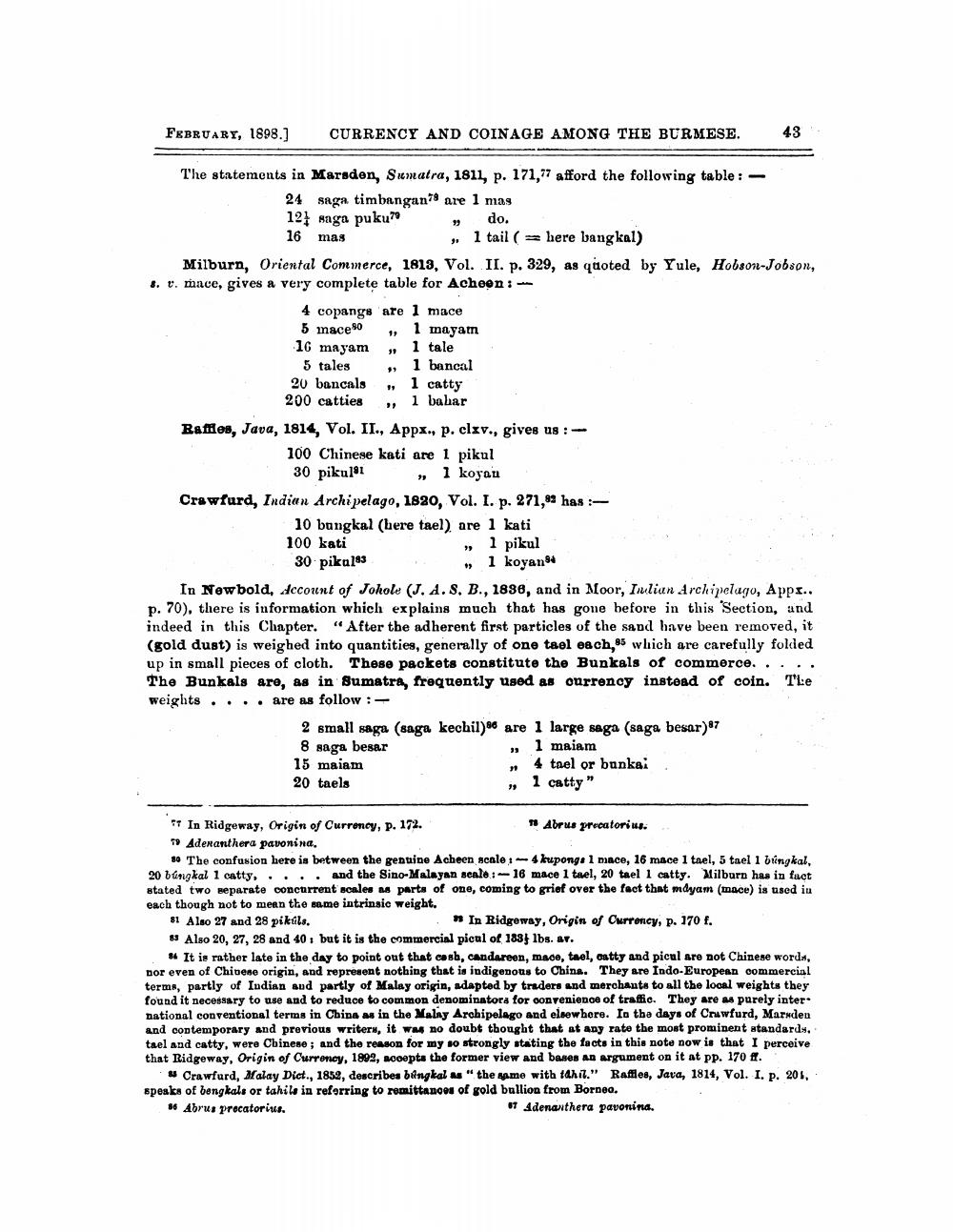________________
FEBRUARY, 1898.]
The statements in Marsden, Sumatra, 1811, p. 171,77 afford the following table: -
24 saga timbangan79 are 1 mas 12 saga puku79 do.
16
mas
CURRENCY AND COINAGE AMONG THE BURMESE.
99
,, 1 tail (here bangkal)
Milburn, Oriental Commerce, 1813, Vol. II. p. 329, as quoted by Yule, Hobson-Jobson, 8. v. mace, gives a very complete table for Acheen:
4 copangs are 1 mace
5 maces0 16 mayam 5 tales 20 bancals ,, 1 catty 200 catties ,, 1 bahar
53
11
1 mayam " 1 tale
1 bancal
Raffles, Java, 1814, Vol. II., Appx., p. clxv., gives us :
100 Chinese kati are 1 pikul 30 pikul 1 ,, 1 koyau
Crawfurd, Indian Archipelago, 1820, Vol. I. p. 271,82 has :10 bungkal (here tael) are 1 kati 100 kati 1 pikul ", 1 koyan
39
30 piku193
In Newbold, Account of Johole (J. A. S. B., 1888, and in Moor, Indian Archipelago, Appx.. p. 70), there is information which explains much that has gone before in this Section, and indeed in this Chapter. "After the adherent first particles of the sand have been removed, it (gold dust) is weighed into quantities, generally of one tael each,85 which are carefully folded up in small pieces of cloth. These packets constitute the Bunkals of commerce. . . . . The Bunkals are, as in Sumatra, frequently used as currency instead of coin. The weights .... are as follow:
2 small saga (saga kechil) are 1 large saga (saga besar) 87 8 saga besar
1 maiam
15 maiam
20 taels
43
39
4 tael or bunkai 1 catty"
In Ridgeway, Origin of Currency, p. 172.
18 Abrus precatorius.
T9 Adenanthera pavonina.
80 The confusion here is between the genuine Acheen scale: 4 kupongs 1 mace, 16 mace 1 tael, 5 tael 1 bungkal, 20 búngkal 1 catty, . . . . and the Sino-Malayan scale: 16 mace 1 tael, 20 tael 1 catty. Milburn has in fact stated two separate concurrent scales as parts of one, coming to grief over the fact that mayam (mace) is used in each though not to mean the same intrinsic weight.
81 Also 27 and 28 piküls.
"In Ridgeway, Origin of Currency, p. 170 f. 83 Also 20, 27, 28 and 40: but it is the commercial picul of 183 lbs. av.
54 It is rather late in the day to point out that cash, candareen, mace, tael, catty and picul are not Chinese words, nor even of Chinese origin, and represent nothing that is indigenous to China. They are Indo-European commercial terms, partly of Indian and partly of Malay origin, adapted by traders and merchants to all the local weights they found it necessary to use and to reduce to common denominatora for convenience of traffic. They are as purely inter national conventional terms in China as in the Malay Archipelago and elsewhere. In the days of Crawfurd, Marsden and contemporary and previous writers, it was no doubt thought that at any rate the most prominent standards, tael and catty, were Chinese; and the reason for my so strongly stating the facts in this note now is that I perceive that Ridgeway, Origin of Currency, 1992, accepts the former view and bases an argument on it at pp. 170 ff.
Crawfurd, Malay Dict., 1852, describes bungkal as "the same with tahil." Raffles, Java, 1814, Vol. I. p. 20, speaks of bengkals or tahile in referring to remittances of gold bullion from Borneo.
86 Abrus precatorius.
67 Adenanthera pavonina.




